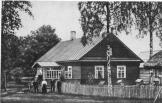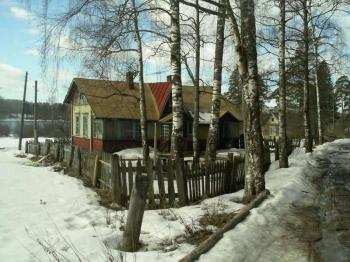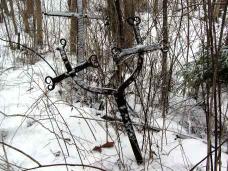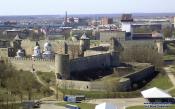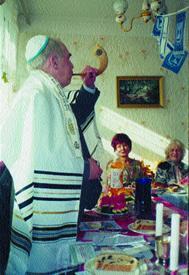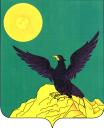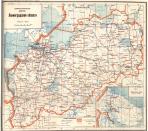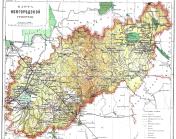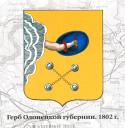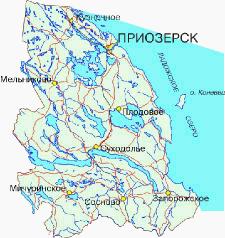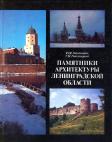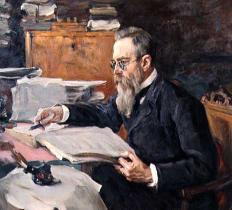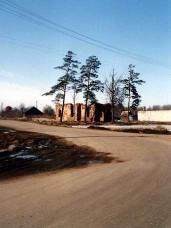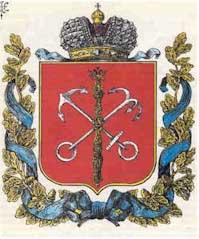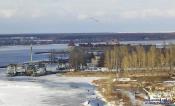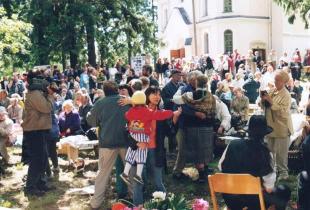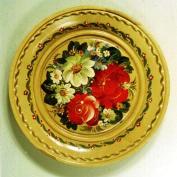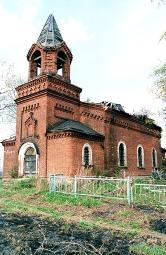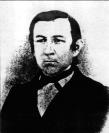|
hidden
|
Book Trade
BOOK TRADE.On the territory of Saint Petersburg Gubernia book trade showed slow progress due to the closeness of a large Saint Petersburg market which almost satisfied the public's need for books.By 1904 the specialized book trade had been... more
|
|
|
hidden
|
Chelishchev, Petr Ivanovich (1745-1811) , a literary man
Chelishchev, Petr Ivanovich (1745-1811) , a literary man, traveller. In 1766 he finished the Page Corps. Chelishchev together with the group of graduates (A.N. Radishchev was among them) were sent to the Leipzig University. In 1770 he returned into... more
|
|
|
hidden
|
Children libraries
CHILDREN’S LIBRARIES
Before 1917 libraries for children in the Saint Petersburg Gubernia were mainly libraries at secondary public colleges, parish schools, etc. Children formed a substantial (about 60 to 70 per cent) part of the reader audience in... more
|
|
|
|
hidden
|
Estonians
Estonians (their native name is Eestlased, old use - Maarakhvas) is an ethnic community. The Estonian language is related to the Baltic-Finnic subgroup od the Finno-Ugric branch of the Uralic language family. They live in Estonia (963 thousand... more
|
|
|
|
hidden
|
Finns
Finns (old use - Chukhnas, their native name is Suomalaiset) is an ethnic community which is a part of the population of the Leningrad Oblast. In the world there are more than 5 million Finns. They are the main population of Finland (4,6 million... more
|
|
|
|
hidden
|
Finns of Ingermanlandia
Finns of Ingermanlandia (Finns-Inkeri, Finns of Leningrad; old use - Chukhonets, Maimists; their own native names - Soumalaiset, Inkerin Suomolaiset) are an ethnic community. They speak local accents of the eastern dialects (the Baltic-Finnic... more
|
|
|
|
hidden
|
Gypsies
Gypsies (their native name is Roma) is an ethnic community which is a part of the population of the Leningrad Oblast. The descendants of the migrants from Germany and Sweden related to the group of "Russian Roma" were noted on the territory of the... more
|
|
|
|
hidden
|
Ingermanlandia
INGERMANLANDIA (Swed. Ingermanland, Rus. Izhora Land or Ingria), historic and cultural region in the western part of the Leningrad Oblast (Kingisepp, Volosovo, Lomonosov, Vsevolozhsk, Gatchina, Tosno, western part of Kirovsk Districts.) The western... more
|
|
|
|
hidden
|
Islam
Islam. Devotees of Islam, mainly tatars, appeared in the St Peresburg Guberniya in the early 18th с, when the working people, from the central regions of Russia, were assembled for building the new capital city according to the order of Peter I.... more
|
|
|
hidden
|
Ivangorod, town
IVANGOROD, a town in Kingisepp District. Population: 11,200. Located at the western border of Leningrad Oblast. Established in1492, when a stone fortress named in honor of Ivan III, Grand Prince of Moscow and All Russia (see Ivangorod Fortress) was... more
|
|
|
|
hidden
|
Ivanovsky, Lev Konstantinovich (1845-1892), a scientist
Ivanovsky, Lev Konstantinovich (1845-1892), a doctor, archaeologist, anthropologist. He graduated the Medical and Surgical Academy in 1869 with the gold medal and he was suggested to work as an assistant lecturer at the descriptive anatomy... more
|
|
|
hidden
|
Judaism
Judaism. This Confession began to disseminate in the St Petersburg Guberniya from the middle of the 19th century. In 1863 the Rabbi activity was permited in St Petersburg and the first prayer meetinghouse was opened, in 1893 the Choral... more
|
|
|
|
hidden
|
Kingisepp Town coat of arms and flag, the
The Kingisepp Town's coat of arms is the official approved heraldic emblem of the Municipal Union “Kingisepskoye gorodskoe poselenie” (the urban-type settlement of Kingisepp) (it was approved with the decision of the Soviet of Deputies of the... more
|
|
|
|
hidden
|
Larin, Paraske (1883/34-1904), a narrator of runes
Paraske Larin or Praskovia Nikitichna (Larina-Stepanova, née Nikitina) (1833/34, the Saint Petersburg Gubernia - 1904, Vaskela Village of the Vyborg Gubernia) was an Izhorian singer of runes and narrator. She was born in Miskyulya Village (it's the... more
|
|
|
|
hidden
|
Leningrad Oblast, the
LENINGRAD OBLAST, subject territory of RF. Area: 83,900 sq. Km (max. Extension from west to east: 446 km, north to south: 325 km.) Population (as of 2002): 1,669,000. The Oblast borders Pskov and Novgorod Oblasts in the south, Vologda Oblast in the... more
|
|
|
|
hidden
|
Luga, town
LUGA, town, adm. center of Luga District. Located 142 km (139 by railway) south of St. Petersburg on the Luga River, after which it was given its name. Population: 40,400. The town is a junction of motor and railroad routes to St. Petersburg,... more
|
|
|
|
hidden
|
Maps and plans
MAPS AND PLANS. The oldest M.a .P. of the Leningrad Oblast area are dated 16th century. The Neva Land and the Karelian Isthmus with the towns of Noteborg (Schlusselburg) and Kexholm (Priozersk), although with many distortions, are presented in... more
|
|
|
|
hidden
|
Nezhgostitsi, a country estate
Nezhgostitsi, a country estate (the sanatorium "Krasny Val", the Luga district). It was the family estate of the boyars Sukins. In the 20th century the estate belonged to A.Ya. Sukin, the commandant of the Peter and Paul Fortress. Under A.Ya. Sukin... more
|
|
|
|
hidden
|
Nikonov, Nikolay Nikitich (1849 - 1918), an architect
Nikolay Nikitich Nikonov (1849 - 1918), an architect,expert of the "russian style". From the 1860s Nikonov learned at the Academy of Arts in St. Petersburg. During 1893-1906 Nikonov was the architect of the St. Petersburg Eparchy. He was the... more
|
|
|
|
hidden
|
Novgorod Gubernia, the
NOVGOROD GUBERNIA, adm. and territorial unit in the north-west of Russia in the 18th – early 20th centuries. It was established in 1727 to comprise five provinces of St. Petersburg Gubernia: Novgorod, Pskov, Velikiye Luki, Tver, and Belozersk. In... more
|
|
|
|
hidden
|
Novosaratovka, a settlement of Germen-colonists
Novosaratovskaya colony (the present village of Novosaratovka of Vsevolozhsk District) is a settlement of Germans - colonists on the right bank of the Neva River. It was founded by immigrants from Württemberg and Brandenburg in 1765. In the 18th... more
|
|
|
hidden
|
Obonezhye
OBONEZHYE, historic and cultural region in the north-west of the European Russia. It included lands around Lake Onega. A part of the state of Novgorod: written sources from the 12th century mention the Obonezhskaya Hundred as an adm. and territorial... more
|
|
|
|
hidden
|
Old Belief
Old Belief. The movement of the Russian Orthodox (Old Belivers, ""schimatics"") having the rites which existed before the reforms of Tsar Alexei Mikhailovich and Patriarch Nikon (the middle of the 17th c). Old Belief are divided into the Popovtsy... more
|
|
|
|
hidden
|
Olonets Gubernia, the
OLONETS GUBERNIA, adm. and territorial unit in the North-West of Russia in the late 18th – early 20th century. Olonets Province (Oblast) was established in1773, with Olonets as its center. In 1776, the province was added to the new-established... more
|
|
|
|
hidden
|
Orekhovo, village
OREKHOVO (Finnish Raasuli before 1948), a village in Priozersk District. Population: 3. Located on the Priozersk Highway. There is also Orekhovo optional stop (population: 57) on the St. Petersburg-Priozersk railway branch. It was mentioned in... more
|
|
|
hidden
|
Priozersk District
PRIOZERSK DISTRICT, municipal entity. Population: 63,300 (of these, 20,500 live in Priozersk town, the adm. center.) Area: 3,563.1 sq. km. Located in the eastern and north-eastern parts of the Karelian Isthmus. It borders Vsevolozhsk and Vyborg... more
|
|
|
|
hidden
|
Priozersk, town
PRIOZERSK (Korela; Kexholm until 1948; Finnish Käkisalmi,) town, adm. center of Priozersk District. Population: 19,300. From 1310, the center of Russian possessions in Karelia. It belonged to Sweden in 1580-95 and in 1611-1710. It became territory... more
|
|
|
|
hidden
|
Protection of monuments of history and culture
The protection of history and culture monuments. Issues of the monuments protection are germane to the degree of their studying, right description and fixing. In Russia, the beginnings of interest in monuments of native antiquity were reflected in... more
|
|
|
|
hidden
|
Rimsky-Korsakov, Nikolay Andreyevich (1844-1908), a musician
RIMSKY-KORSAKOV, Nikolay Andreyevich (1844, Tikhvin Town - 1908, Lyubensk estate S.-Petersburg Gubernia), composer, teacher, conductor, public figure. In 1862 Rimsky-Korsakov graduated from the Navy military school, until 1865 he served on board... more
|
|
|
|
hidden
|
Russian-Estonian deanary
Russian-Estonian deanary. People of the Baltic States were originally baptized by the Orthodox Church, from 13th с they were converted in Catholicism, from 16th с they were converted in Lutheran. In 1841 the Estonia peasants began to convert... more
|
|
|
|
hidden
|
Saint Petersburg Gubernia coat of arms, the
The Saint Petersburg Gubernia's coat of arms was approved by Emperor on 5 July 1878 and abolished after the Revolution of 1917. Before establishing, according to an unwritten tradition, the Saint Petersburg's coat of arms was also the Saint... more
|
|
|
|
hidden
|
Schlusselburg, town
SCHLÜSSELBURG (Petrokrepost in 1944-92), a town in Kirovsk District. In 1996–2005, a separate municipal entity. Population: 12,400. Located at the head of the Neva River, on its left bank. S. is connected by bus service to Kirovsk and St.... more
|
|
|
|
hidden
|
Sculptures and monuments
Sculptures and monuments. The first sculpture samples appeared in St. Petersburg outskirts at the time of peter I ruling. During the 18th century decorative sculpture was the inherent part of park ensembles of Peterhof, Oraniyenbaum, Tsarskoye... more
|
|
|
|
hidden
|
Sectarianism
Sectarianism. Religious societies, which do not belong to the World religions, are divided conditionally into societies having the West origin, the Russian origin and the East origin. The Seventh Day Adventists (it was formed in the first half of... more
|
|
|
hidden
|
Sestra River, the
SESTRA (Swedish Systerback, Finnish Rajajoki / “Frontier River”), a river in Vsevolozhsk and Vyborg Districts of Leningrad Oblast and in St. Petersburg. Length: 74 km. Depth: up to 3 m (in the mouth.) Catchment area: 393 sq. km. It begins in a marsh... more
|
|
|
|
hidden
|
Uhannus, a festival
UHANNUS, festivity. This festivity is well known among the Finns from pre-Christian times, it was celebrated on the day of Summer Solstice (the Day of Ivan – Finnish Uhannus). The Luthran church celebrates Uhannus on June 24th (public street... more
|
|
|
|
hidden
|
v. Sankt-Peterburg Gubernia, the
ST. PETERSBURG GUBERNIA, historic adm. and territorial unit of Russia. Established in 1708 by the decree of Peter I subdividing Russia into eight gubernias. It included the areas of the current Leningrad, Novgorod, Pskov, and Tver Oblasts, and... more
|
|
|
|
hidden
|
Volkhov painting movement
VOLKHOV TOWN PAINTING SCHOOL. Traditions of wood painting are typical for the folklore decorative handicraft developed in the settlements situated in Ladoga Lake area. In St.Petersburg Gubernia the most famous was Volkhov Town Painting School... more
|
|
|
|
hidden
|
Volkhov District
VOLKHOV DISTRICT, a part of Leningrad Oblast. Area: 5124 sq. km, population: 97,300. Established in 1927. Adm. center: Volkhov Town. V. D. comprises the towns of Syasstroy and Novaya Ladoga, and 277 rural localities. Located south of Lake Ladoga on... more
|
|
|
|
hidden
|
Yevropeus, Daniel (1820-18884), a scholar
David Emmanuel Daniel Europaeus (in Finnish - Taneli; in Russian - David Petrovich) (1820-1884) was a folklorist, archaeologist. Ethnographer. He was born in the family of a pastor in Olkkola Farmstead of the parish of Savitaipale of the Vyborg... more
|
|
|




